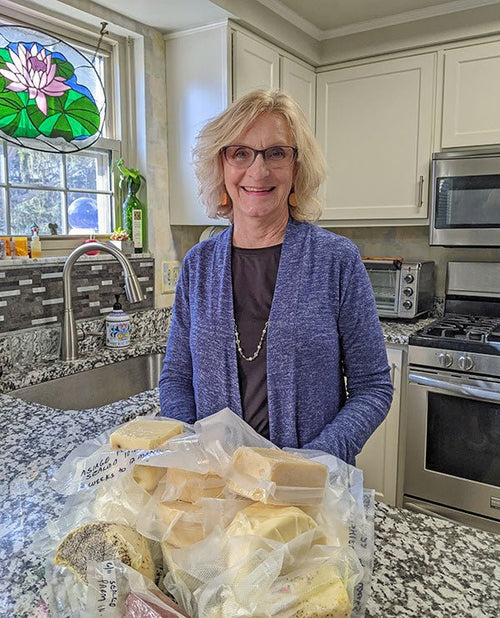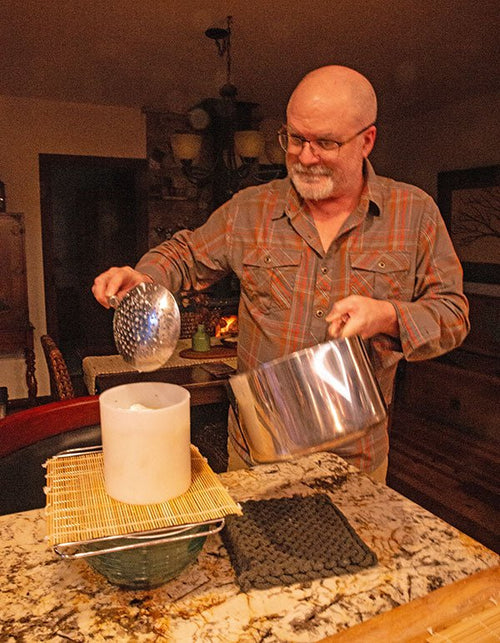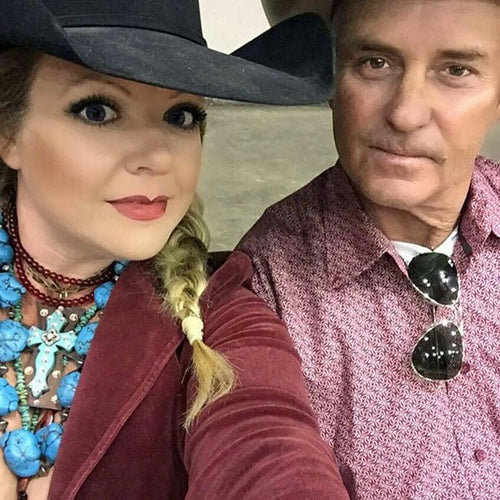Cheese Making Recipe of the Month
Cardoona, a Cheese Made with Flowers
After a full year of working with cardoon (thistle) rennet, I am ready to share a wonderful and original recipe with you today.
This cheese can loosely be classified as a washed rind cheese. When using cardoon (thistle) rennet, the ripening of the cheese is very different because this rennet does not stop working like other types of rennet do.
Although it is a much weaker rennet, it keeps breaking down the proteins as the cheese ages. Because of this, the aging period for this cheese is surprisingly quick.
Cheese Making Questions & Answers
Hard cheeses have all come out extra sharp or to the point of sour?
Q. I have been fairly successful with fresh cheeses, however, my hard cheeses have all come out extra sharp or to the point of sour. Gouda, Colby and Monterey Jack have all been cut at the earliest maturing time and they are very sharp.
I boil all my utensils. And I use Star San on all surfaces. I wash my hands and then rinse them in vinegar before I start cheese making. What am I doing wrong?
A. The issue is probably not in sanitation but in developing excessive acid. Try cutting back on the amount of culture you add. Some milks just need less. Also, make sure you dry the curds enough before you drain the whey.
How long should I wait for the flavor I'm looking for?
Q. I made some feta and the next day the product smelled wonderful before salting and aging - just like feta. However, I tasted a sliver and there was virtually no flavor. Is this typical at this stage? I'm looking for maximum flavor, so time is no issue. How long should I wait for the flavor I'm looking for?
A. When you did the sampling, the cheese was too young. All it had going for it was the flavor of the milk with it's sweetness removed due to lactose conversion.
It is the aging of feta that develops the flavors it’s known for. The longer it’s aged - the more character. This can be a few months to a year and longer.
The bottom is still a little wet ?
Q. I just finished molding 2 gals of cow milk cheddar: half grass fed raw milk from a local farm and half lightly pasteurized from another local farm. I weighted it for 24 hours with the weight suggested in your recipe.
It’s three days in to the air dry. The bottom is still a little wet with whey when I turn it and there is a small bubble forming under the rind on one end. Does this mean it’s not going to work out?
A. With 3 days of air dry, it should not be wet. This may be a sign that your curd was not dry enough when you drained the whey and a late fermentation is still going on. When this happens, the cheese will sometimes produce gas. Keep turning it daily to see if it dries out.
However, do not let it dry to the point of cracking.
Keeping the humidity at 90-94% during aging?
Q. I am making Brie and I have a hard time keeping the humidity at 90-94% during aging. I use a small dorm fridge for my aging space.
A. The final moisture is normally done with open pans of water in the aging space. Or, even better, using covered plastic boxes which holds the humidity up due to the moisture in the cheese itself.
Cheese turning white?
Q. Friends gave us 2 chevre packets to try a while ago and we loved what we got except that the cheese is very dry and crumbly.
We have a goat share and we pick up the raw milk on Tuesdays. There is cream on top of the jar after 4 or 5 days to the point that I can make ice cream (on the weeks I don't try to make cheese).
The first time, I started the cheese process on Thursday 11am and by 8:30pm, it was coagulated. I placed the curds in a lined colander with a thick cheese cloth in a stainless steel pot. I waited till Saturday 2:30 pm (42 hrs) to salt it and refrigerate it.
The second time, as it felt already dry, I let it drain less time: 16 hours. It tasted de-li-cious but it was really crumbly.
I measured that I get 550 grams (19 ounces) of goat cheese for 1 gallon of whole raw goat milk and bit over 1/2 gallon of whey.
A. The first batch issues were likely from developing too much acidity which produces a dry and granular cheese. It could have been drained too warm or too long.
The yield was quite low as well, which would result from high acid or excess drawing of whey. High acid also cause a loss of calcium which will cause a lack of continuity in the cheese.
It would be unusual to have such high acid develop in the short set time you indicate. It is possible that the milk was already developing acid before you began. (You mention letting milk set for 5 days before use in your ice cream. This would allow plenty of opportunity for acid milk.)
Raw milk needs to be used within 2-3 days of milking.
Have a cheese making question, we're here for you: info@cheesemaking.com
Meet a Fellow Cheese Maker
Dela Ends in Brodhead, Wisconsin
It's been over 24 years since Dela and her husband, Tony began growing organic vegetables and raising goats on their small farm. In the first few years, Dela became a mother, a cheese maker, a bread baker, a soap maker, etc. Later, she became a well known activist and advocate for women farmers.
In 2009, she attended the first meeting of the Soil Sisters, a loosely knit group of women farmers who have been getting together ever since for potlucks, workshops, farm tours, etc.
She then founded the South Central chapter of the Wisconsin Farmers Union and served on the board of her CSA for 7 years.
In 2016, Dela and two other women were dubbed the "Cookie Crusaders" when they sued the State of Wisconsin to be able to sell baked goods at farmer's markets, CSA's, etc. (Knowing what you know about Dela so far, do you think they won their case?!)
The list of Dela's achievements goes on and on, yet Dela found the time to write to us about how much she likes our kits and how she uses them in her cheese making workshops.
It was certainly an honor for us to interview her!
Fun With the Cheese Queen
Fig Rennet
I saw your blog article on cheese made with fig tree branches (click here) and had to share the picture of this amazing cheese made by a relative on one of the Greek islands!
This is an a really yummy cheese and tastes very mild and creamy! No bitter taste at all.
The lady who made it said that she had very fresh goat milk, hot from the goat. She got a small branch of the fig tree and cut some slits in it and soaked it in water... and then added this water to the goat milk.
She boiled the goat milk till it just started bubbling and switched it off and then mixed the milk with a huge washed branch of the fig tree till the curds separated from the whey.
She then strained it into that metal thing pictured behind the cheese to allow it to mould!
It has a taste like freshly made mozzarella. Very mild and a bit chewy!
I found your website after visiting her as I wanted to see the science behind it.
Maryam E, Sydney, Australia
St. Nectaire
Here is a photo of Jim’s recipe for St Nectaire style cheese - YUMMY!!! His recipes are the BEST!!!
I made this cheese with 12 gallons of fresh raw, whole milk from my Jersey cow - Heidi.
Sue O’Dwyer, Lone Wolf Cheese,Harrisville, New Hampshire
Please send your cheese making news & photos to: moosletter@cheesemaking.com
Cheese Making 1,2 & 3
Learn all about the ingredients, equipment and process for making cheese at home. This beginner's guide will walk you through the process from start to finish.
Beginner FAQ's
Got a question? We've got an answer. From milk and cream to rennet and aging, our FAQ section is filled with answers to all your home cheese making questions.










































































































































